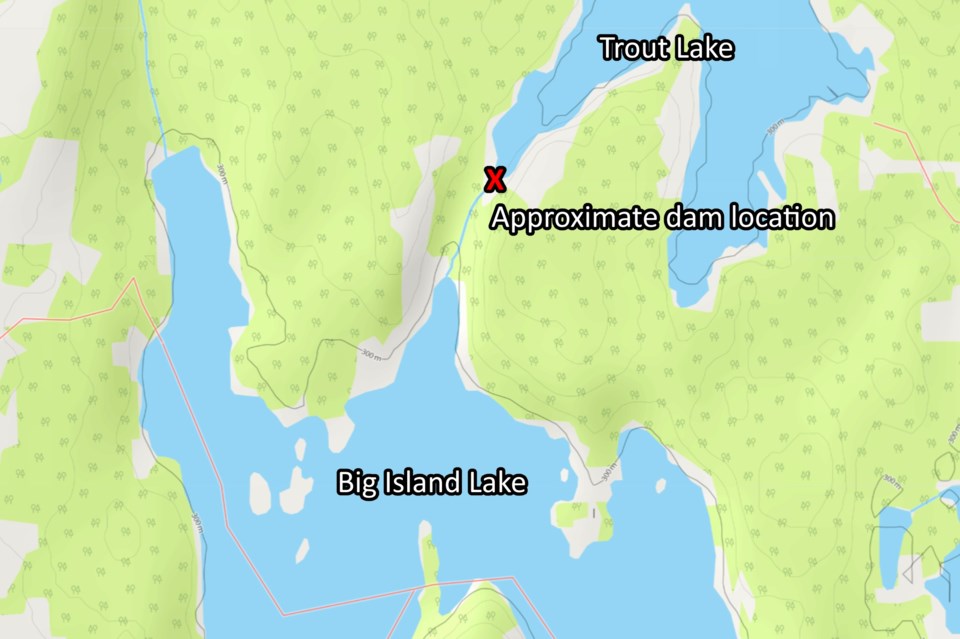Hudbay is weighing its options for a nearly century-old dam at Trout Creek, including potential decommissioning or replacing the dam.
Representatives of the company, along with engineers and assessors, spoke at a public meeting at the Victoria Inn Sept. 26 on the dam’s future and what Hudbay’s next steps regarding it may be.
The dam is located at the very southern tip of Trout Lake on Trout Creek, a stream that drains from the lake into Big Island Lake immediately south of it. The dam was originally built out of timbers and concrete in the 1930s to raise the water level of Trout Lake and provide a fresh water source for both Hudson Bay Mining and Smelting and the City of Flin Flon.
Company staff and engineers from AECOM, the engineer of record tasked with the dam’s maintenance, are still considering what options come next for the dam and how that decision will effect water both up and down stream. The dam still undergoes annual inspections, along with biannual underwater inspections underneath the creek using divers - those will continue until the dam is replaced or decommissioned, both ideas that Hudbay is considering. The next inspection is set for next month.
“We want to try and get this structure to what we call a passive closure or a walk-away state, where it's in a configuration that we can minimize the attention we need to pay to it on a regular basis. We also need to make sure that we're still going to maintain water depths and such that are required for supplying water, for the City and for any potential future use otherwise,” said Hudbay manager of geoengineering and tailings Trevor Ross.
Decommissioning the dam would likely take multiple years to receive the needed permits from federal and provincial authorities. The Department of Fisheries and Oceans would need to approve the project, as the creek and lake contain fish and there may be impacts on fish habitat or spawning - a different review would be done through the Transport Act, because Trout Lake is a large and navigable lake and modifying water levels could mean changes for navigation.
“You would think it would be relatively easy to remove a dam that was built in the 1930s that nobody needs anymore. Sounds pretty easy, but it's actually not - it's quite complicated,” said Cliff Samoiloff, senior scientist and project manager with AECOM.
“There's a number of different both federal and provincial agencies that you’d have to get the approval to do it.”
The dam has seen changes recently. The dam, built from wood and concrete, had several logs put up on its top to help regulate water flow. Recently, lower water levels at Trout Lake led to the removal of several logs on top of the dam.
“The top of the dam is essentially fixed, so it holds the maximum water level up to the crest of the dam. In some years, we see the water level come down due to temperature and evaporation. If it rains, then it'll fill up. Depending on whether we have a wet year or a dry year, that's what really controls the water levels in Trout Lake,” said Ross.
With the shutdown of 777 mine and much of its Flin Flon-area operations, Hudbay’s own needs for water have gone done considerably.
“The biggest thing is the water use has changed pretty significantly. We're not pulling near as much water anymore than we did back when it was first constructed and when the Trout Lake mine was operating and the Flin Flon complex was fully operational. We were drawing a lot more water during those times,” said Ross.
In the meantime, inspections will continue as planned with the dam, pending any further decisions on its fate.
“I think it’d be really unlikely for us to have the same kind of freshwater needs - at the same time, this is definitely something we need to consider because I think our direction for the Flin Flon area is to keep it in an operating state - that’s something we’re considering as part of this,” said Landice Yestrau, Hudbay’s manager of environmental control.
Downstream from the dam is Schist Lake and Lake Athapapuskow - upstream from Trout Lake in the same watershed sits Cliff Lake, where the City of Flin Flon currently gets most of its drinking water.
Company representatives say there will be more meetings about the dam and its future held at a later date.




